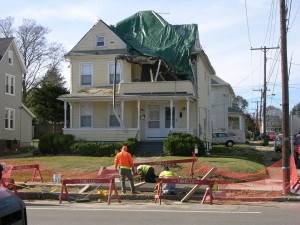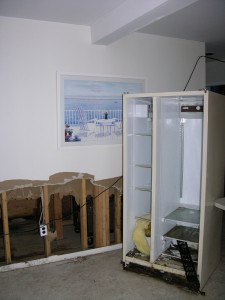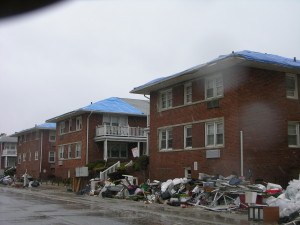This report is the second in a series from AIR Worldwide’s ongoing damage survey of areas impacted by Sandy, which made landfall on October 29, 2012, five miles southwest of Atlantic City, New Jersey. The commentary here will illustrate the kinds of damage patterns caused by this event from coastal communities in Rhode Island and Connecticut surveyed on November 6 and Long Island on November 7.
“In the areas surveyed, wind damage in the vast majority of cases was limited to light damage to roof shingles, roof flashing and siding,” said Cagdas Kafali, principal engineer, research at AIR Worldwide. “The few instances of severe building damage were the result of downed trees or telephone poles. Condominium structures performed better than single family residences with respect to wind, and commercial signage and window openings fared very well.”
“Surge damage, where observed, was far more severe. In the Connecticut and Rhode Island areas surveyed, only structures on the immediate coast were severely damaged by surge. In Long Island, there were more examples of entire neighborhoods that were inundated with surge waters. In these areas, a significant number of properties within a few blocks of the coast showed signs of building and contents damage. Cars, pleasure boats, and other heavy objects were picked up and moved, indicating the force of the surge.”
Rhode Island
Carpenter’s Beach, South Kingstown
At Roy Carpenter’s Beach, of the 11 structures nearest to the beachfront, three floated away and four others were taken off of their foundations due to a combination of surge and beach erosion.
Matunuck Beach, South Kingstown
In neighboring Matunuck Beach, no wind damage was observed, even to mobile homes, which are particularly vulnerable. Almost all the homes the AIR team saw in this area were of similar construction – wood frame homes with asphalt shingle roofs.
Misquamicut, Westerly
There was a significant cleanup effort in progress in Misquamicut. A large amount of sand had been carried ashore. Most structures were boarded up, and wind damage was limited to some roof flashing or siding. The street closest to the coast—Atlantic Avenue—was lined with commercial properties, some of which suffered severe surge damage. Residential structures were more common a few blocks in. There was evidence of surge waters (in the form of sand left behind) having reached more than 600 feet inland.
Watch Hill, Westerly
Watch Hill is a coastal area in the town of Westerly, where 41 mph sustained winds were recorded. Homes in the historic district tend to be high value mansions. Of the 50 structures observed on the Watch Hill Cove “loop,” only one had multiple shingles missing. There was evidence of high winds in the form of downed trees and branches, but damage was limited. Businesses near the coast were closed and possibly damaged from surge, but raised homes near the coast appeared undamaged.
Connecticut
Connecticut coastal communities experienced damage patterns similar to Rhode Island’s.
New London

In New London, sustained wind speeds of 45 mph were recorded, and the AIR team saw the most widespread (if not the most severe) damage of the day here. On Pequot and Montauk Avenues, which border the harbor, roof damage was seen on approximately 10 percent of homes. The only case of severe damage, however, was due to a tree falling on a house. In addition, some boats had been damaged, including one that had sunk (likely due to smashing into the dock).
Cosey Beach, East Haven
In Cosey Beach, some homes immediately next to the coast experienced severe surge-related damage (entire walls and decks missing, foundations eroded), but wind damage was sparse in general. There were examples of roof damage in these areas, but they were the exceptions. Local residents in Cosey Beach told the team that two homes had been destroyed by surge, with four others possibly compromised. The AIR team could not visit this area to verify, as it was cordoned off by police. According to residents, all six of these homes had been damaged by Irene (2011) and had since been repaired.
“An apartment building on Coe Avenue had had its roof torn off,” said Kafali. “This was noteworthy because it was much farther inland than the coastal locations where the team had observed very little damage. It is possible that the building height and flat roof were exacerbating factors. Also, from the twisted metal lying on the street in front of the building, it is possible that there had been some roof-attached structures that had introduced additional vulnerability and caused a part of the roof to peel up.”
Long Island
MacArthur Airport Area, Islip
In the neighborhood surrounding MacArthur Airport, a gust of 81 mph had been recorded. AIR teams observed, only about 2% of the houses experienced wind damage there. It appears the high gust did not pack enough punch to cause significant damage in these areas.
Little East Neck

Little East Neck is very close to the coast. At this location, the AIR Team saw some of the most severe damage of the day, driven by storm surge flooding. Of the homes closest to the coast, it appeared that about 20 percent had some visible roof damage, but water-related impacts were truly devastating. One homeowner told us that her house had flooded, with water rising to 55 inches inside the home.
Residents reported the surge reached as much as a half mile inland, likely damaging any homes that were not appropriately raised.
Massapequa
Conditions were generally comparable to Little East Neck in nearby Massapequa, another coastal location. Light wind damage was commonly seen, along with evidence of significant flooding (debris, contents littering the streets).
Long Beach
Kafali noted, “The area of Long Beach was slightly different than the other coastal towns surveyed. There were many more apartment buildings and hotels, with residential structures located a few blocks inland. Most of the apartment structures nearest the coast had brick or concrete walls that fared well, but large amounts of contents had been discarded and lay in piles along the sidewalks. Wind damage was observed on about 5 percent of houses closest to coast, and many vehicles seemed to have been left exposed or abandoned during the event.”

Farmingdale Airport Area
Sustained winds of 45 mph and a gust of 71 mph were recorded in the Farmingdale Airport area. Like the area around MacArthur airport, this is an inland location, so the AIR team was looking for wind damage only. About 5% of structures near this wind measurement had experienced some wind damage. With one exception of siding damage, all instances seen were roof related.
Another report will follow about additional areas surveyed in New Jersey and New York.
Source: AIR Worldwide
Was this article valuable?
Here are more articles you may enjoy.

 Roof Repair and Replacement Costs up Nearly 30% Since 2022, Report Shows
Roof Repair and Replacement Costs up Nearly 30% Since 2022, Report Shows  GSK Zantac Appeal Gets Tough Questions From Some US Judges
GSK Zantac Appeal Gets Tough Questions From Some US Judges  US Officials Mull Easing Tariffs Targeting the Auto Industry
US Officials Mull Easing Tariffs Targeting the Auto Industry  Group Sues California Department of Insurance Over FAIR Plan Surcharges
Group Sues California Department of Insurance Over FAIR Plan Surcharges 